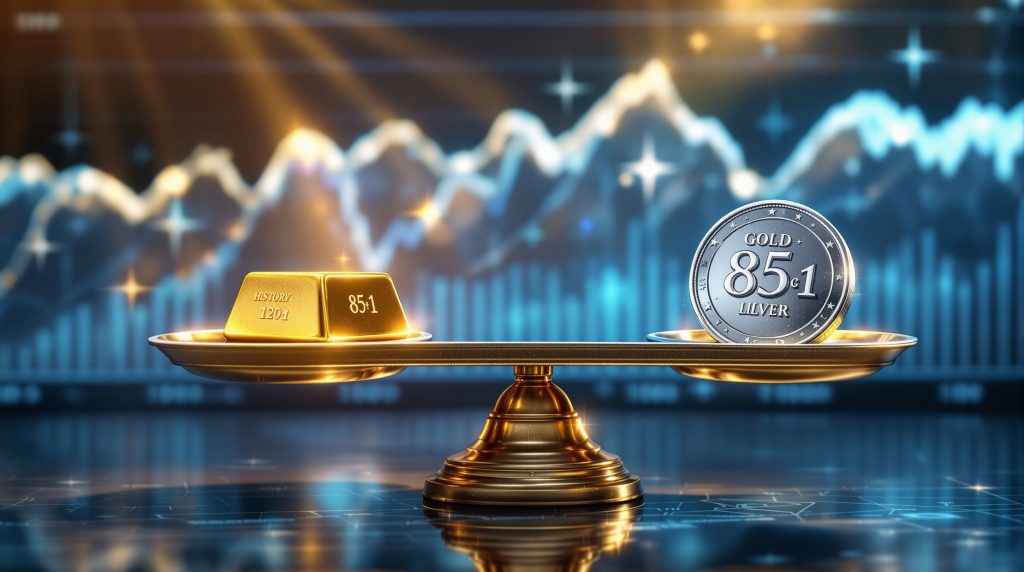Understanding the Gold-Silver Ratio: A Comprehensive Guide for Precious Metals Investors
The gold-silver ratio represents how many ounces of silver it takes to purchase one ounce of gold. This fundamental metric serves as a crucial barometer for precious metals investors, offering insights into relative valuation and potential investment opportunities. When the ratio is high, silver is relatively inexpensive compared to gold; when low, silver is relatively expensive.
The ratio is calculated using a simple formula:
Gold-Silver Ratio = Price of Gold per Ounce ÷ Price of Silver per Ounce
As of September 2025, with gold trading near $3,700 and silver around $43, the current gold-silver ratio analysis stands at approximately 85:1, reflecting the relative valuation between these two precious metals.
Historical Context of the Gold-Silver Ratio
The relationship between gold and silver prices has evolved dramatically throughout history:
- Ancient civilizations: The ratio was often fixed by decree, typically between 10:1 and 15:1
- U.S. bimetallism era (1792-1873): Officially maintained at 15:1 by the Coinage Act of 1792, later adjusted to 16:1 in 1834
- Modern era (post-1971): Fluctuated within a broader range after the end of the Bretton Woods system
- Recent extremes: Has fluctuated between 15:1 (1980) to over 120:1 (2020)
This historical context provides investors with reference points to evaluate current market conditions. The ratio's movements often signal important shifts in market psychology and economic conditions that savvy investors can leverage for strategic decisions.
How Do Market Cycles Affect the Gold-Silver Ratio?
Bull Market Behavior
During precious metals bull markets, the gold-silver ratio typically contracts as silver outperforms gold. This pattern emerges because:
- Silver has greater industrial demand components than gold, with approximately 50% of silver demand coming from industrial applications compared to only about 10% for gold
- Silver's smaller market size makes it more volatile and responsive to increased investment demand
- Retail investors often favor silver during bullish periods due to its affordability and perception as "poor man's gold"
When precious metals enter strong uptrends, silver tends to accelerate faster than gold in the later stages of the move. This phenomenon was evident in both the 1970s bull market and the 2005-2011 cycle, where silver dramatically outpaced gold near cyclical peaks.
Bear Market Behavior
Conversely, during bear markets or economic uncertainty, the ratio tends to expand as:
- Gold's monetary properties and safe-haven status become more valued
- Industrial demand for silver weakens during economic contractions
- Institutional investors typically favor gold over silver during market stress
The 2008 financial crisis provided a clear example of this behavior, as the ratio expanded dramatically while investors sought gold's stability during financial market turmoil.
Current Cycle Analysis (2025)
The ratio currently stands around 85:1, suggesting we may be in a transitional phase. Recent patterns indicate:
- Gradual contraction from the 2020 peak above 120:1
- Increased volatility as markets respond to monetary policy shifts
- Potential for further ratio compression as silver has begun outperforming in the current precious metals uptrend
Technical analysis of the gold-silver ratio shows it recently lost support at its 200-day moving average, suggesting further downside potential toward the 80:1 level. This technical breakdown could foreshadow continued silver market squeeze in the coming months.
What Factors Drive Changes in the Gold-Silver Ratio?
Economic and Monetary Influences
The ratio responds dynamically to changing economic conditions:
- Interest rates: Higher rates typically pressure both metals but affect silver more severely due to its industrial demand component
- Inflation expectations: Rising inflation concerns often benefit both metals, with silver potentially outperforming
- Currency strength: Dollar weakness generally supports precious metals prices, with silver sometimes showing heightened sensitivity
- Central bank policies: Quantitative easing tends to boost both metals, while tightening cycles apply pressure
The Federal Reserve's policy decisions exert particularly strong influence, as changes in real interest rates (nominal rates minus inflation) directly impact precious metals through opportunity cost considerations.
Supply-Demand Fundamentals
Physical market dynamics significantly impact the ratio:
- Mining production: The natural occurrence ratio of silver to gold in the Earth's crust is approximately 17:1 to 20:1, yet annual mining output is closer to 8:1
- Industrial demand: Silver's substantial industrial applications (electronics, solar panels, medical uses) create demand pressures not present for gold
- Investment demand: Shifts between physical bullion, ETFs, and mining stocks affect both metals differently
- Recycling rates: Gold has higher recycling rates (approximately 30%) compared to silver (20%)
The Silver Institute reports that industrial applications account for roughly half of all silver demand, making economic activity a critical driver for silver prices that doesn't affect gold to the same degree.
Sentiment and Positioning
Market psychology plays a crucial role in ratio movements:
- Speculator positioning: Futures market commitments often signal potential turning points
- Retail sentiment: Physical buying patterns from smaller investors influence price discovery
- Technical analysis signals: Chart patterns and momentum indicators that traders follow can create self-fulfilling prophecies
The futures market positioning, in particular, often provides early warning signals of potential ratio reversals, as speculative extremes frequently coincide with important turning points.
How Can Investors Use the Gold-Silver Ratio as a Trading Strategy?
Ratio Trading Approaches
The gold-silver ratio offers several strategic opportunities for precious metals investors:
1. Metal Switching Strategy
This approach involves converting between gold and silver based on extreme ratio readings:
- When the ratio is historically high (above 80:1): Convert gold to silver
- When the ratio is historically low (below 40:1): Convert silver to gold
Example calculation:
- Starting with 1 oz gold when ratio is 100:1
- Convert to 100 oz silver
- Wait for ratio to fall to 50:1
- Convert back to 2 oz gold (100 ÷ 50)
- Net result: 100% increase in gold holdings
The key to this strategy is patience, as ratio normalization can take months or even years. Historical data shows major ratio peaks in 1991 (100:1) took several years to normalize, while the 2020 spike above 120:1 began correcting within weeks.
2. Pair Trading
This strategy involves simultaneously:
- Going long on the undervalued metal
- Going short on the overvalued metal
This creates a market-neutral position that profits from the ratio normalizing rather than depending on absolute price movements. This approach can be implemented using futures, options, or ETFs like GLD and SLV.
3. Rebalancing Approach
A more conservative method involving:
- Maintaining target allocations between gold and silver (e.g., 50/50 by value)
- Periodically rebalancing when the ratio reaches predetermined thresholds
- Systematically selling the outperformer to buy the underperformer
This approach harnesses mean-reversion tendencies without requiring perfect timing of extreme ratio readings.
Risk Management Considerations
Effective ratio trading requires disciplined risk management:
- Position sizing: Limiting exposure to a manageable percentage of portfolio
- Stop-loss levels: Predetermining exit points if the ratio moves unfavorably
- Time horizons: Understanding that ratio normalization can take months or years
- Transaction costs: Accounting for premiums, spreads, and potential taxes
These factors become particularly important when using leveraged instruments like futures or options to implement ratio trading strategies.
What Are the Key Ratio Levels Investors Should Watch?
Historical Significance Zones
Certain ratio levels have proven historically significant:
| Ratio Level | Historical Significance | Potential Action |
|---|---|---|
| 120+ | Extreme high – only seen briefly in 2020 | Strong silver buying opportunity |
| 80-100 | Upper historical range – seen during major economic stress | Moderate silver buying opportunity |
| 50-80 | Modern "normal" range | Neutral positioning |
| 30-50 | Lower historical range – typically during PM bull markets | Consider increasing gold allocation |
| Below 30 | Extreme low – rarely seen (1980) | Strong gold buying opportunity |
These ranges provide approximate guidelines rather than exact trading signals. Context matters—the ratio's direction and momentum often prove as important as absolute levels.
Technical Analysis Framework
Chart patterns and technical indicators often provide additional insights:
- Moving averages: 50-day and 200-day crossovers signal potential trend changes
- Momentum oscillators: RSI and MACD help identify overbought/oversold conditions
- Support/resistance levels: Previous ratio turning points often act as future reversal zones
- Trend analysis: Identifying whether the ratio is in a clear trend or consolidation phase
As of September 2025, the gold-silver ratio has recently broken below its 200-day moving average, suggesting further downside potential toward the 80:1 level—a development that could signal continued silver outperformance.
How Does the Ratio Perform During Different Economic Scenarios?
Inflation Environments
During periods of elevated inflation:
- Both metals typically perform well in absolute terms
- Silver often outperforms gold, causing the ratio to contract
- The ratio's decline can accelerate if inflation coincides with strong industrial growth
The 1970s provided the clearest historical example of this pattern, when the ratio contracted dramatically as inflation soared to double-digit levels, eventually reaching an extreme low near 15:1 in 1980.
Deflationary Pressures
When deflationary forces dominate:
- Gold typically outperforms silver as monetary properties take precedence
- The ratio tends to expand, sometimes dramatically
- Industrial demand for silver weakens, removing a key support factor
The 2008 global financial crisis demonstrated this pattern, as deflationary fears caused silver to underperform gold significantly, expanding the ratio to nearly 85:1.
Economic Growth Phases
Strong economic expansion generally:
- Boosts industrial demand for silver
- Creates a favorable environment for ratio compression
- Supports mining output of both metals
Manufacturing PMI (Purchasing Managers' Index) data often correlates with silver's relative performance, with readings above 50 (indicating expansion) typically supporting silver outperformance.
Recessionary Periods
During economic contractions:
- Safe-haven flows favor gold over silver
- Industrial silver demand contracts
- The ratio typically expands, sometimes rapidly
The COVID-19 pandemic in early 2020 provided an extreme example, as the ratio spiked above 120:1 when industrial activity collapsed globally while monetary stimulus supported gold market performance.
How Do Mining Economics Impact the Gold-Silver Ratio?
Primary vs. By-Product Production
The production dynamics of both metals influence the ratio:
- Approximately 70% of silver is produced as a by-product of other metal mining (copper, lead, zinc)
- Most gold comes from primary gold mines
- This production difference means supply responses to price signals differ between the metals
When base metal prices rise, silver production often increases regardless of silver prices, creating potential supply-driven pressure on the ratio.
Production Costs and Profitability
Mining economics create different supply responses:
- All-in sustaining costs (AISC): Typically $1,000-1,200/oz for gold vs. $15-20/oz for silver
- Profit margins: At current prices (gold $3,700, silver $43), gold miners generally enjoy higher margins
- Project development: New gold projects require higher capital expenditure per ounce produced
These cost structures mean that supply responses to price changes differ significantly between the two metals, influencing the ratio during different market phases.
Resource Depletion Concerns
Long-term supply factors worth considering:
- Reserve grades: Both metals have experienced declining ore grades over decades
- Discovery rates: Major new discoveries have decreased despite increased exploration spending
- Production peaks: Some analysts suggest peak gold production may occur within this decade
The U.S. Geological Survey (USGS) reports that both metals face ongoing grade declines, though silver's status as a by-product provides some supply insulation that pure gold deposits lack.
What Are Common Misconceptions About the Gold-Silver Ratio?
"The Ratio Must Return to Historical Averages"
While mean reversion occurs, there's no guarantee the ratio will return to specific historical levels:
- Economic and monetary systems have evolved significantly since the gold/silver standard era
- Industrial uses for silver have expanded dramatically, changing fundamental demand drivers
- Investment vehicles and market access have transformed how capital flows into precious metals
The 16:1 ratio maintained during the U.S. bimetallism era reflected government policy rather than free-market equilibrium, making it an inappropriate benchmark for today's markets.
"The Ratio Predicts Absolute Price Movements"
The ratio indicates relative value, not absolute price direction:
- A falling ratio can occur during both rising and falling absolute prices
- The ratio may normalize through gold falling faster than silver rather than silver rising
- Correlation with broader markets varies across different timeframes
Investors must analyze the ratio alongside fundamental drivers for both metals rather than using it as a standalone predictive tool.
"The Earth's Crustal Ratio Determines the 'Natural' Price Ratio"
The 17:1 to 20:1 crustal abundance ratio is often cited but:
- Economic factors, not geological abundance, determine market prices
- Extraction costs, recycling rates, and demand patterns vary significantly between the metals
- The market ratio has rarely aligned with the geological ratio in modern times
Economic utility and monetary demand ultimately drive pricing, with geology playing only an indirect role through production costs and supply constraints.
How Can Investors Incorporate the Gold-Silver Ratio Into Portfolio Strategy?
Diversification Benefits
The ratio helps optimize precious metals allocation:
- Correlation analysis: Gold and silver have different correlations with stocks and bonds
- Volatility management: Silver's higher volatility can be strategically utilized or mitigated
- Sector exposure: Silver provides greater industrial economy exposure than gold
Gold has historically shown better diversification benefits during equity market stress, while silver offers higher potential returns during economic expansion phases.
Long-Term Strategic Allocation
For long-term investors:
- Core holdings: Maintaining baseline allocations to both metals
- Tactical adjustments: Using ratio extremes for minor rebalancing
- Dollar-cost averaging: Systematic purchasing regardless of ratio levels
A balanced approach might maintain fixed proportions (like 70% gold, 30% silver by value) with periodic rebalancing when allocations drift significantly from targets.
Short-Term Tactical Opportunities
For more active investors:
- Momentum-based entries: Entering positions when the ratio breaks significant technical levels
- Mean-reversion plays: Positioning for normalization after extreme readings
- Options strategies: Using calls/puts on metal ETFs to capitalize on ratio movements
As of September 2025, with the ratio near 85:1 and breaking below its 200-day moving average, tactical investors might consider increasing silver allocations in anticipation of continued ratio compression.
Frequently Asked Questions About the Gold-Silver Ratio
What is considered a "normal" gold-silver ratio?
While there is no universally agreed "normal" level, the modern era (post-1971) has seen the ratio average between 45:1 and 65:1. However, significant deviations have occurred during economic stress or precious metals bull markets.
The concept of "normal" continues to evolve as monetary systems and industrial applications change, making historical comparisons imperfect guides for future expectations.
Does the ratio predict future precious metal prices?
The ratio itself doesn't predict absolute prices but indicates relative valuation. Extreme readings have historically preceded significant relative performance differences between the metals.
However, both metals could rise or fall in absolute terms even as the ratio changes, making it crucial to consider broader economic conditions alongside ratio analysis.
How quickly does the ratio typically normalize after reaching extremes?
Normalization timeframes vary considerably:
- The 1980 extreme low (15:1) corrected within months
- The 1991 high (100:1) took several years to normalize
- The 2020 spike above 120:1 began correcting within weeks
Market conditions, including monetary policy, inflation trends, and industrial demand, significantly influence the pace of normalization.
How do ETFs and paper trading affect the gold-silver ratio?
The growth of ETFs and derivatives markets has:
- Increased accessibility to ratio trading strategies
- Potentially amplified short-term ratio volatility
- Created occasional disconnects between paper and physical markets
Products like GLD and SLV have made implementing ratio strategies more accessible to retail investors, though physical metal conversions remain popular among long-term holders.
What other metal ratios should investors monitor?
Complementary ratios that provide additional insights include:
- Gold:Platinum ratio
- Silver:Platinum ratio
- Gold:Oil ratio
- Gold:Copper ratio
These alternative ratios offer different perspectives on economic conditions and relative value opportunities beyond the traditional gold-silver relationship.
Maximizing the Value of Ratio Analysis
The gold-silver ratio remains one of the most powerful analytical tools for precious metals investors. By understanding its historical context, driving factors, and practical applications, investors can make more informed decisions about:
- Optimal timing for precious metals purchases
- Strategic allocation between different metals
- Potential outperformance opportunities
- Risk management in metals portfolios
As of September 2025, with gold prices analysis showing prices near $3,700 and silver at $43, the ratio stands at approximately 85:1—a level that suggests potential further silver outperformance if historical patterns hold. The ratio's recent break below its 200-day moving average provides a technical signal that reinforces this possibility.
While no single metric can provide perfect investment guidance, the gold-silver ratio offers valuable perspective on relative value in the precious metals space. By combining ratio analysis with fundamental research and sound risk management, investors can enhance their gold investment strategies and potentially improve long-term results.
Disclaimer: This article is for informational purposes only and does not constitute investment advice. Precious metals investing involves risk, and past performance is not indicative of future results. Consult with a qualified financial advisor before making investment decisions.
Searching for the Next Major Mining Discovery?
Discover significant ASX mineral discoveries in real-time with Discovery Alert's proprietary Discovery IQ model, which transforms complex mining data into actionable investment insights. Explore why major mineral discoveries can lead to substantial returns by visiting Discovery Alert's dedicated discoveries page and begin your 30-day free trial today.




